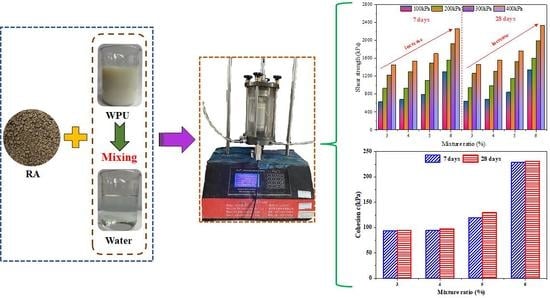Triaxial Mechanical Properties and Mechanism of Waterborne Polyurethane-Reinforced Road Demolition Waste as Road Bases
Abstract
:1. Introduction
2. Experimental Materials, Schemes, and Methods
2.1. Materials
2.2. Experimental Scheme
2.3. Specimen Preparation
- (1)
- The RA was placed in a constant-temperature oven at 105 °C for 24 h to ensure that the moisture in the RA was completely dried, and then cooled to room temperature.
- (2)
- The corresponding qualities of the RA, WPU solution, and water were weighed according to the mix proportion set in Table 3. Then, the weighed water was slowly poured into the WPU solution while stirring. Afterward, the WPU solution was mixed with the RA.
- (3)
- An amount of 154 g of the mixture stirred evenly was shaped in a cylindrical mold with a height of 80 mm and a diameter of 39.1 mm. It must be fully compacted with a jack and statically pressed for 10 min.
- (4)
- The specimens were demolded after being fully compacted. Then, the specimens were cured in a standard curing box for 7 and 28 days, respectively. The curing temperature was controlled at 20 ± 2 °C, and the relative humidity was >95%.
2.4. Experimental Method
2.4.1. UU Test
2.4.2. SEM Test
3. Results and Discussions
3.1. Deviatoric Stress–Strain Behaviors
3.2. Shear Strength
3.3. Failure Strain
3.4. Shear Strength Parameters
4. Mechanism Analysis
5. Conclusions
- (1)
- WPU can obviously improve the shear strength of RA. The shear strength of PURD increases with the increase in WPU content. When the WPU content is 6%, the shear strength reaches the maximum value, which is nearly 30% higher than that of PURD-5. However, the curing time has little effect on the reinforcement effect of WPU, and the increase in shear strength can be ignored. Therefore, WPU can directly exert all strength effects in a short curing time, and is relatively flexible in engineering application, which is a very effective and promising new type of high-molecular polymer reinforcement material.
- (2)
- WPU has great influence on the ductility of RA. The failure strain of PURD increases with the increase in confining pressure, and first increases and then decreases with the increase in WPU content. The failure strain of PURD-5 reaches the maximum value. Compared with PURD-3, the failure strain of PURD-5 increases by 41%, 50%, 124%, and 99% at 7 days and 61%, 37%, 31%, and 41% at 28 days, respectively. The growth range is large, so PURD-5 shows the best ductility.
- (3)
- WPU can obviously increase the cohesion of RA. The internal friction angle and cohesion of PURD increase with the increase in WPU content, which is highly consistent with the change law of shear strength. However, the increase in internal friction angle is small, only about 5%, and the increase in cohesion is obvious. At the curing time of 7 days, the cohesion of PURD-6 increases by 144%, 142%, and 91%, respectively, compared with those of PURD-3, PURD-4, and PURD-5. At the curing time of 28 days, the cohesion of PURD-6 increases by 141%, 134%, and 77%, respectively, compared with those of PURD-3, PURD-4, and PURD-5.
- (4)
- The enhancement effect of the polymer can be attributed to the spatial reticular membrane structure produced by wrapping and bonding particles with the polymer film. With the increase in WPU content, the internal pore and crack size of PURD gradually decreases, and the number of them also decreases. Meanwhile, the polyurethane-wrapped RA particles gradually form agglomerates and finally produce a large number of polyurethane films. With the gradual increase in WPU content, the polyurethane film becomes increasingly thicker, which makes the bonding effect of the polyurethane on the RA particles become increasingly stronger, and the overall structure of the PURD becomes increasingly denser.
- (5)
- In this test, the mechanical strength of RA is obtained on the basis that the mud content is 20.5%. If different practical projects need to obtain higher mechanical parameters, it is necessary to reduce the mud content of RA. Similarly, if the engineering has low requirements for mechanical parameters, the requirements for mud content can be appropriately relaxed. Thus, the processing steps for RA can be appropriately reduced.
Author Contributions
Funding
Institutional Review Board Statement
Informed Consent Statement
Data Availability Statement
Conflicts of Interest
References
- Liu, C.; Liu, H.; Zhu, C.; Bai, G. On the mechanism of internal temperature and humidity response of recycled aggregate concrete based on the recycled aggregate porous interface. Cement Concrete Comp. 2019, 103, 22–35. [Google Scholar] [CrossRef]
- Golafshani, E.M.; Behnood, A.; Hosseinikebria, S.S.; Arashpour, M. Novel metaheuristic-based type-2 fuzzy inference system for predicting the compressive strength of recycled aggregate concrete. J. Clean. Prod. 2021, 320, 128771. [Google Scholar] [CrossRef]
- Raza, A.; Rafique, U. Efficiency of GFRP bars and hoops in recycled aggregate concrete columns: Experimental and numerical study. Compos. Struct. 2021, 255, 112986. [Google Scholar] [CrossRef]
- Tang, Z.; Li, W.; Tam, V.W.; Luo, Z. Investigation on dynamic mechanical properties of fly ash/slag-based geopolymeric recycled aggregate concrete. Compos. Part B-Eng. 2020, 185, 107776. [Google Scholar] [CrossRef]
- Yue, Y.; Zhou, Y.; Xing, F.; Gong, G.; Hu, B.; Guo, M. An industrial applicable method to improve the properties of recycled aggregate concrete by incorporating nano-silica and micro-CaCO3. J. Clean. Prod. 2020, 259, 120920. [Google Scholar] [CrossRef]
- Shaban, W.M.; Elbaz, K.; Yang, J.; Thomas, B.S.; Shen, X.; Li, L.; Du, Y.; Xie, J.; Li, L. Effect of pozzolan slurries on recycled aggregate concrete: Mechanical and durability performance. Constr. Build. Mater. 2021, 276, 121940. [Google Scholar] [CrossRef]
- Wang, Y.; Zhang, S.; Niu, D.; Su, L.; Luo, D. Strength and chloride ion distribution brought by aggregate of basalt fiber reinforced coral aggregate concrete. Constr. Build. Mater. 2020, 234, 117390. [Google Scholar] [CrossRef]
- Wang, Y.; Huang, J.; Wang, D.; Liu, Y.; Zhao, Z.; Liu, J. Experimental study on hygrothermal characteristics of coral sand aggregate concrete and aerated concrete under different humidity and temperature conditions. Constr. Build. Mater. 2020, 230, 117034. [Google Scholar] [CrossRef]
- Bai, G.; Zhu, C.; Liu, C.; Liu, B. An evaluation of the recycled aggregate characteristics and the recycled aggregate concrete mechanical properties. Constr. Build. Mater. 2020, 240, 117978. [Google Scholar] [CrossRef]
- Zhang, Y.; Luo, W.; Wang, J.; Wang, Y.; Xu, Y.; Xiao, J. A review of life cycle assessment of recycled aggregate concrete. Constr. Build. Mater. 2019, 209, 115–125. [Google Scholar] [CrossRef]
- Zhang, L.; Sojobi, A.; Liew, K. Sustainable CFRP-reinforced recycled concrete for cleaner eco-friendly construction. J. Clean. Prod. 2019, 233, 56–75. [Google Scholar] [CrossRef]
- Zhang, L.; Sojobi, A.; Kodur, V.; Liew, K. Effective utilization and recycling of mixed recycled aggregates for a greener environment. J. Clean. Prod. 2019, 236, 117600. [Google Scholar] [CrossRef]
- Mi, R.; Pan, G.; Liew, K.; Kuang, T. Utilizing recycled aggregate concrete in sustainable construction for a required compressive strength ratio. J. Clean. Prod. 2020, 276, 124249. [Google Scholar] [CrossRef]
- Tang, Y.; Feng, W.; Feng, W.; Chen, J.; Bao, D.; Li, L. Compressive properties of rubber-modified recycled aggregate concrete subjected to elevated temperatures. Constr. Build. Mater. 2021, 268, 121181. [Google Scholar] [CrossRef]
- Zhu, P.; Hao, Y.; Liu, H.; Wang, X.; Gu, L. Durability evaluation of recycled aggregate concrete in a complex environment. J. Clean. Prod. 2020, 273, 122569. [Google Scholar] [CrossRef]
- Tang, Z.; Li, W.; Tam, V.W.; Yan, L. Mechanical behaviors of CFRP-confined sustainable geopolymeric recycled aggregate concrete under both static and cyclic compressions. Compos. Struct. 2020, 252, 112750. [Google Scholar] [CrossRef]
- Nanayakkara, O.; Gunasekara, C.; Sandanayake, M.; Law, D.W.; Nguyen, K.; Xia, J.; Setunge, S. Alkali activated slag concrete incorporating recycled aggregate concrete: Long term performance and sustainability aspect. Constr. Build. Mater. 2021, 271, 121512. [Google Scholar] [CrossRef]
- Azúa, G.; González, M.; Arroyo, P.; Kurama, Y. Recycled coarse aggregates from precast plant and building demolitions: Environmental and economic modeling through stochastic simulations. J. Clean. Prod. 2019, 210, 1425–1434. [Google Scholar] [CrossRef]
- Shi, C.; Zou, X.; Yang, L.; Wang, P.; Niu, M. Influence of humidity on the mechanical properties of polymer-modified cement-based repair materials. Constr. Build. Mater. 2020, 261, 119928. [Google Scholar] [CrossRef]
- Li, M.; Fang, H.; Du, M.; Zhang, C.; Su, Z.; Wang, F. The behavior of polymer-bentonite interface under shear stress. Constr. Build. Mater. 2020, 248, 118680. [Google Scholar] [CrossRef]
- Mohammed, A.; Mahmood, W.; Ghafor, K. TGA, rheological properties with maximum shear stress and compressive strength of cement-based grout modified with polycarboxylate polymers. Constr. Build. Mater. 2020, 235, 117534. [Google Scholar] [CrossRef]
- Joseph, J.; Patel, R.; Wenham, A.; Smith, J. Biomedical applications of polyurethane materials and coatings. Trans. IMF 2018, 96, 121–129. [Google Scholar] [CrossRef] [Green Version]
- Adak, B.; Butola, B.S.; Joshi, M. Effect of organoclay-type and clay-polyurethane interaction chemistry for tuning the morphology, gas barrier and mechanical properties of clay/polyurethane nanocomposites. Appl. Clay Sci. 2018, 161, 343–353. [Google Scholar] [CrossRef]
- Kemona, A.; Piotrowska, M. Polyurethane recycling and disposal: Methods and prospects. Polymers 2020, 12, 1752. [Google Scholar] [CrossRef] [PubMed]
- Chen, R.-D.; Huang, C.-F.; Hsu, S.-H. Composites of waterborne polyurethane and cellulose nanofibers for 3D printing and bioapplications. Carbohyd. Polym. 2019, 212, 75–88. [Google Scholar] [CrossRef]
- Wan, T.; Chen, D. Mechanical enhancement of self-healing waterborne polyurethane by graphene oxide. Prog. Org. Coat. 2018, 121, 73–79. [Google Scholar] [CrossRef]
- Bai, Y.; Liu, J.; Song, Z.; Chen, Z.; Jiang, C.; Lan, X.; Shi, X.; Bu, F.; Kanungo, D.P. Unconfined compressive properties of composite sand stabilized with organic polymers and natural fibers. Polymers 2019, 11, 1576. [Google Scholar] [CrossRef] [Green Version]
- Qi, C.; Bai, Y.; Liu, J.; Bu, F.; Kanungo, D.P.; Song, Z.; He, X. Desiccation cracking behavior of polyurethane and polyacrylamide admixed clayey soils. Polymers 2020, 12, 2398. [Google Scholar] [CrossRef] [PubMed]
- Li, M.; Du, M.; Wang, F.; Xue, B.; Zhang, C.; Fang, H. Study on the mechanical properties of polyurethane (PU) grouting material of different geometric sizes under uniaxial compression. Constr. Build. Mater. 2020, 259, 119797. [Google Scholar] [CrossRef]
- Liu, J.; Bu, F.; Bai, Y.; Chen, Z.; Kanungo, D.P.; Song, Z.; Wang, Y.; Qi, C.; Chen, J. Study on engineering properties of sand strengthened by mixed fibers and polyurethane organic polymer. B. Eng. Geol. Environ. 2020, 79, 3049–3062. [Google Scholar] [CrossRef]
- Wei, J.; Kong, F.; Liu, J.; Chen, Z.; Kanungo, D.P.; Lan, X.; Jiang, C.; Shi, X. Effect of sisal fiber and polyurethane admixture on the strength and mechanical behavior of sand. Polymers 2018, 10, 1121. [Google Scholar] [CrossRef] [PubMed] [Green Version]
- Liu, J.; Qi, X.; Zhang, D.; Feng, Q.; Wang, Y.; Kanungo, D.P. Study on the permeability characteristics of polyurethane soil stabilizer reinforced sand. Adv. Mater. Sci. Eng. 2017, 2017, 5240186. [Google Scholar] [CrossRef] [Green Version]
- Zhang, X.; Fang, H.; Du, M.; Shi, M.; Zhang, C. Experimental Study on the Mechanical Properties of the Fiber Cement Mortar Containing Polyurethane. Adv. Mater. Sci. Eng. 2021, 2021, 9956897. [Google Scholar] [CrossRef]
- Saleh, S.; Yunus, N.Z.M.; Ahmad, K.; Ali, N.; Marto, A. Micro-level analysis of marine clay stabilised with polyurethane. KSCE J. Civ. Eng. 2020, 24, 807–815. [Google Scholar] [CrossRef]
- Liu, P.; Meng, M.; Xiao, Y.; Liu, H.; Yang, G. Dynamic properties of polyurethane foam adhesive-reinforced gravels. Sci. China Technol. Sc. 2021, 64, 535–547. [Google Scholar] [CrossRef]
- Fan, G.; Sha, F.; Yang, J.; Ji, X.; Lin, F.; Feng, C. Research on working performance of waterborne aliphatic polyurethane modified concrete. J. Build. Eng. 2022, 51, 104262. [Google Scholar] [CrossRef]
- JTG E51-2009; Test Methods of Materials Stabilized with Inorganic Bingers for Highway Engineering. Industrial Standards of the People’s Republic of China: Beijing, China, 2009.
- JTG 3430-2020; Test Methods of Soils for Highway Engineering. Industrial Standards of the People’s Republic of China: Beijing, China, 2020.
- GBT 50123-2019; Standard for Geotechnical Testing Method. National Standards of the People’s Republic of China: Beijing, China, 2019.
- Wu, L.; Qian, W.; Liu, J.; Song, Z.; Kanungo, D.P.; Bai, Y.; Bu, F. Sisal Fiber-Polymer–Treated Sand Mechanical Properties in Triaxial Test. Environ. Eng. Geosci. 2020, 26, 227–242. [Google Scholar] [CrossRef]
- Xiao, Y.; Stuedlein, A.W.; Chen, Q.; Liu, H.; Liu, P. Stress-strain-strength response and ductility of gravels improved by polyurethane foam adhesive. J. Geotech. Geoenviron. 2018, 144, 04017108. [Google Scholar] [CrossRef]
- Liu, J.; Bai, Y.; Feng, Q.; Song, Z.; Wei, J.; Sun, S.; Kanungo, D.P. Strength properties of sand reinforced with a mixture of organic polymer stabilizer and polypropylene fiber. J. Mater. Civil. Eng. 2018, 30, 4018330. [Google Scholar] [CrossRef]
- Yuan, B.; Li, Z.; Chen, Y.; Ni, H.; Zhao, Z.; Chen, W.; Zhao, J. Mechanical and microstructural properties of recycling granite residual soil reinforced with glass fiber and liquid-modified polyvinyl alcohol polymer. Chemosphere 2022, 286, 131652. [Google Scholar] [CrossRef]
- Li, C.; Jiang, L. Utilization of limestone powder as an activator for early-age strength improvement of slag concrete. Constr. Build. Mater. 2020, 253, 119257. [Google Scholar] [CrossRef]
- Zhang, L.; Jiang, Z.; Zhang, W.; Peng, S.; Chen, P. Flexural properties and microstructure mechanisms of renewable coir-fiber-reinforced magnesium phosphate cement-based composite considering curing ages. Polymers 2020, 12, 2556. [Google Scholar] [CrossRef] [PubMed]
- Wang, W.; Kang, H.; Li, N.; Guo, J.; Girma, D.Y.; Liu, Y. Experimental investigations on the mechanical and microscopic behavior of cement-treated clay modified by nano-MgO and fibers. Int. J. Geomech. 2022, 22, 04022059. [Google Scholar] [CrossRef]
- Kumarappa, D.B.; Peethamparan, S. Stress-strain characteristics and brittleness index of alkali-activated slag and class C fly ash mortars. J. Build. Eng. 2020, 32, 101595. [Google Scholar] [CrossRef]
- Dong, Q.; Wei, H.; Ma, G. Failure mechanism of S-shaped fissure in brittle materials under uniaxial tension: Experimental and numerical analyses. Int. J. Solids Struct. 2020, 191, 486–496. [Google Scholar] [CrossRef]
- Liu, J.; Wang, Y.; Kanungo, D.P.; Wei, J.; Bai, Y.; Li, D.; Song, Z.; Lu, Y. Study on the brittleness characteristics of sand reinforced with polypropylene fiber and polyurethane organic polymer. Fiber Polym. 2019, 20, 620–632. [Google Scholar] [CrossRef]
- Dijkstra, T.; Rogers, C.; Smalley, I.; Derbyshire, E.; Li, Y.J.; Meng, X.M. The loess of north-central China: Geotechnical properties and their relation to slope stability. Eng. Geol. 1994, 36, 153–171. [Google Scholar] [CrossRef]
- Liu, J.; Bai, Y.; Song, Z.; Kanungo, D.P.; Wang, Y.; Bu, F.; Chen, Z.; Shi, X. Stabilization of sand using different types of short fibers and organic polymer. Constr. Build. Mater. 2020, 253, 119164. [Google Scholar] [CrossRef]
- Masoumi, E.; Abtahi Forooshani, S.M.; Abdi Nian, F. Problematic soft soil improvement with both polypropylene fiber and polyvinyl acetate resin. Geotech. Geol. Eng. 2013, 31, 143–149. [Google Scholar] [CrossRef]
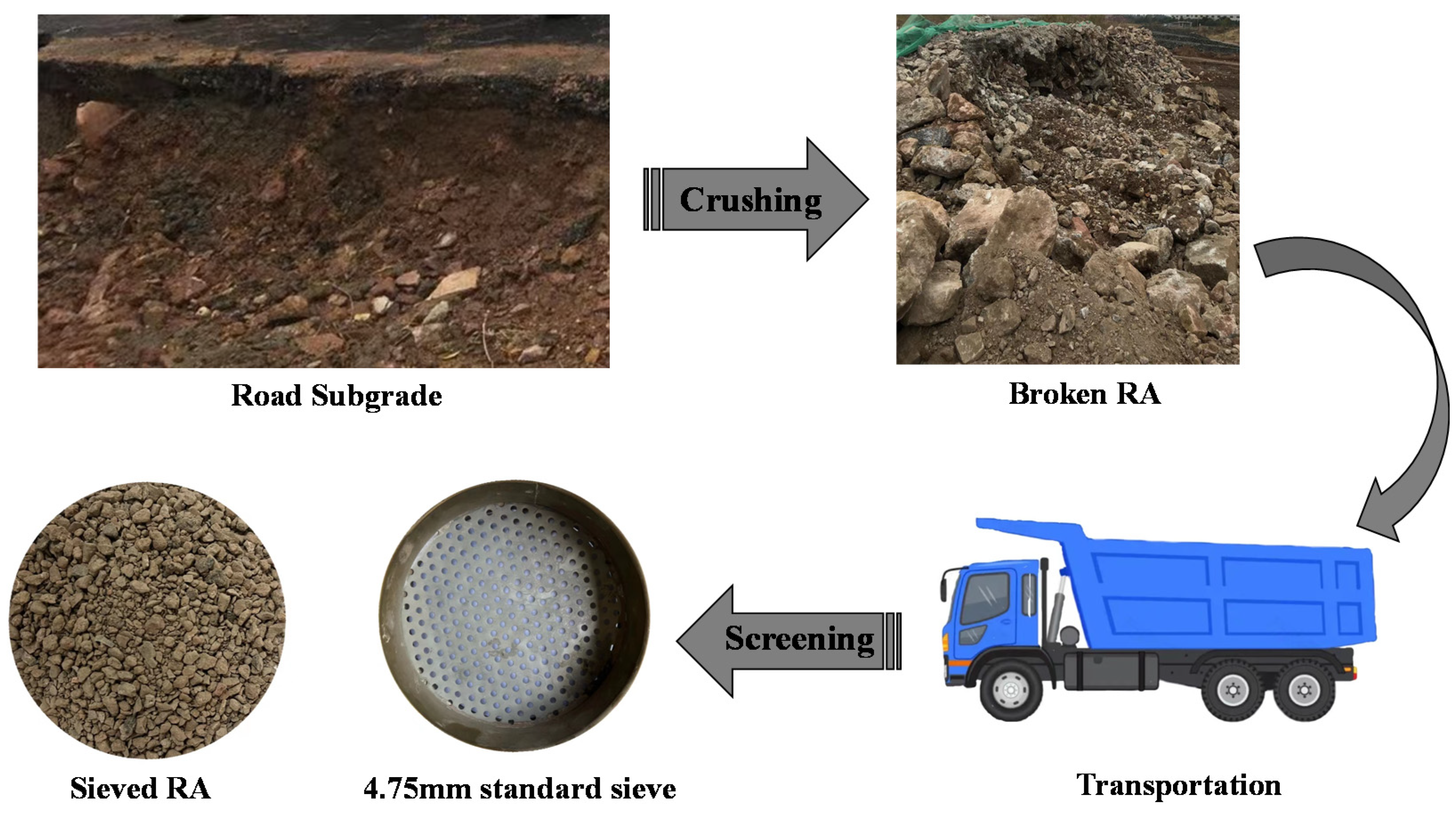

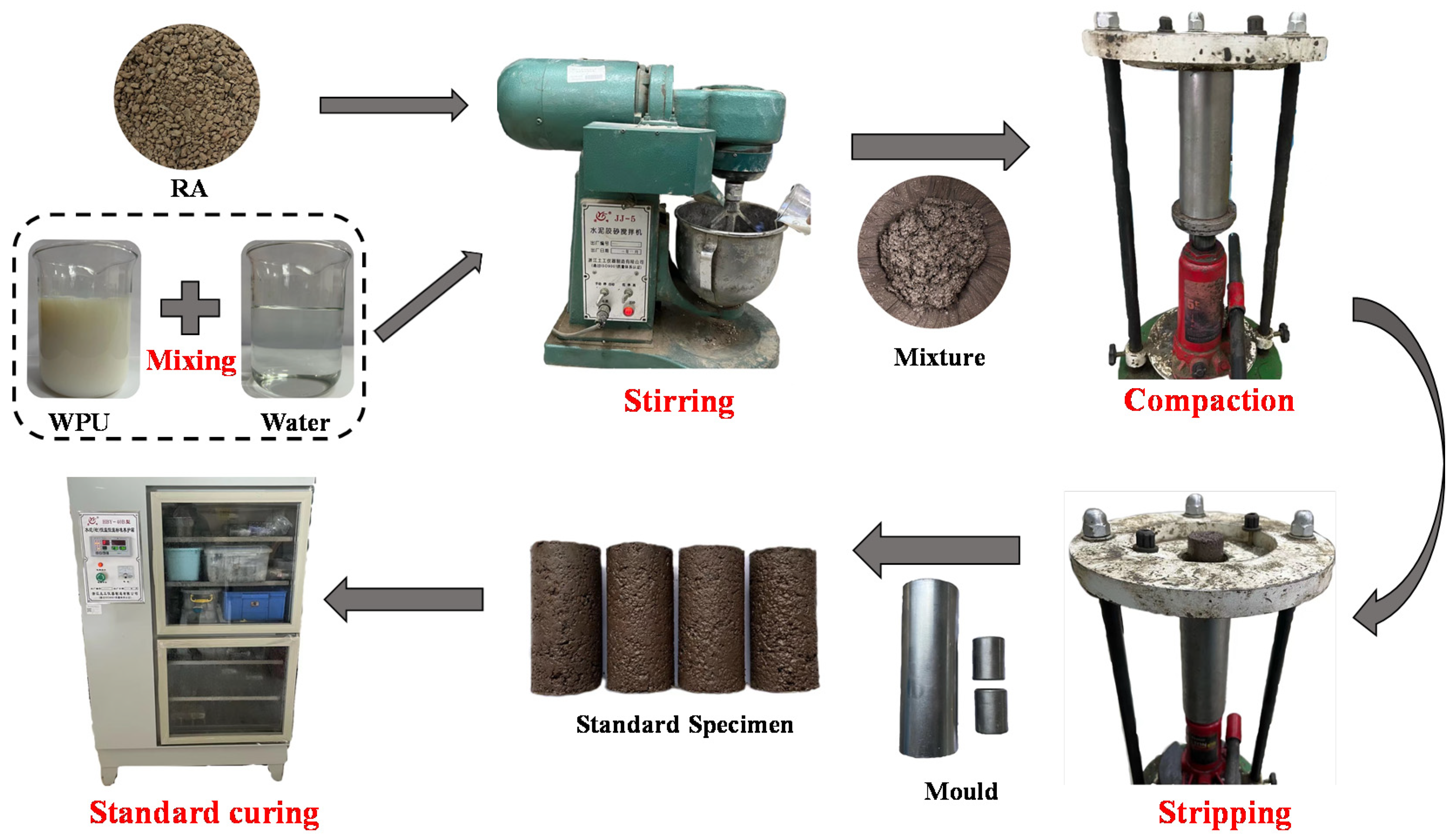
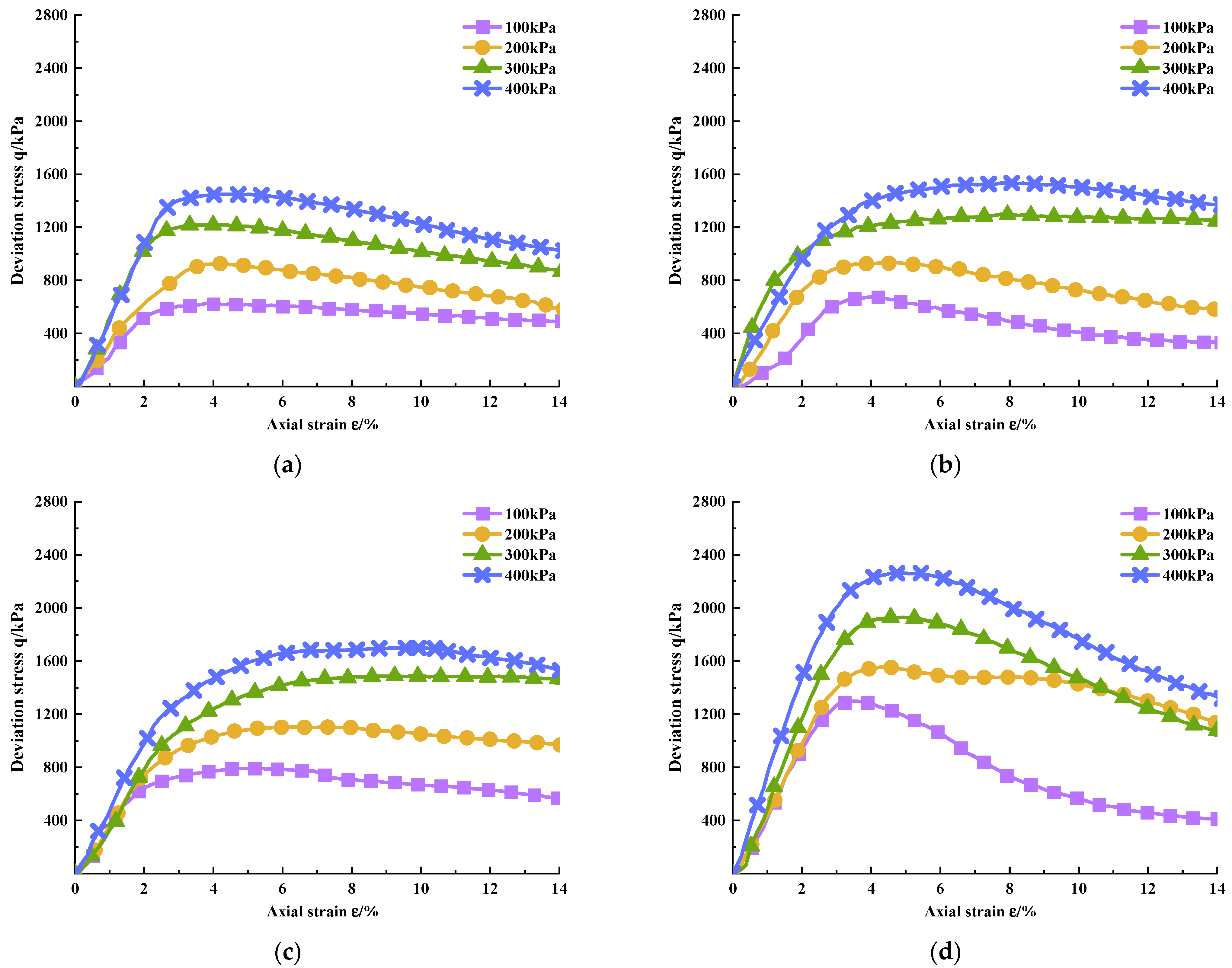
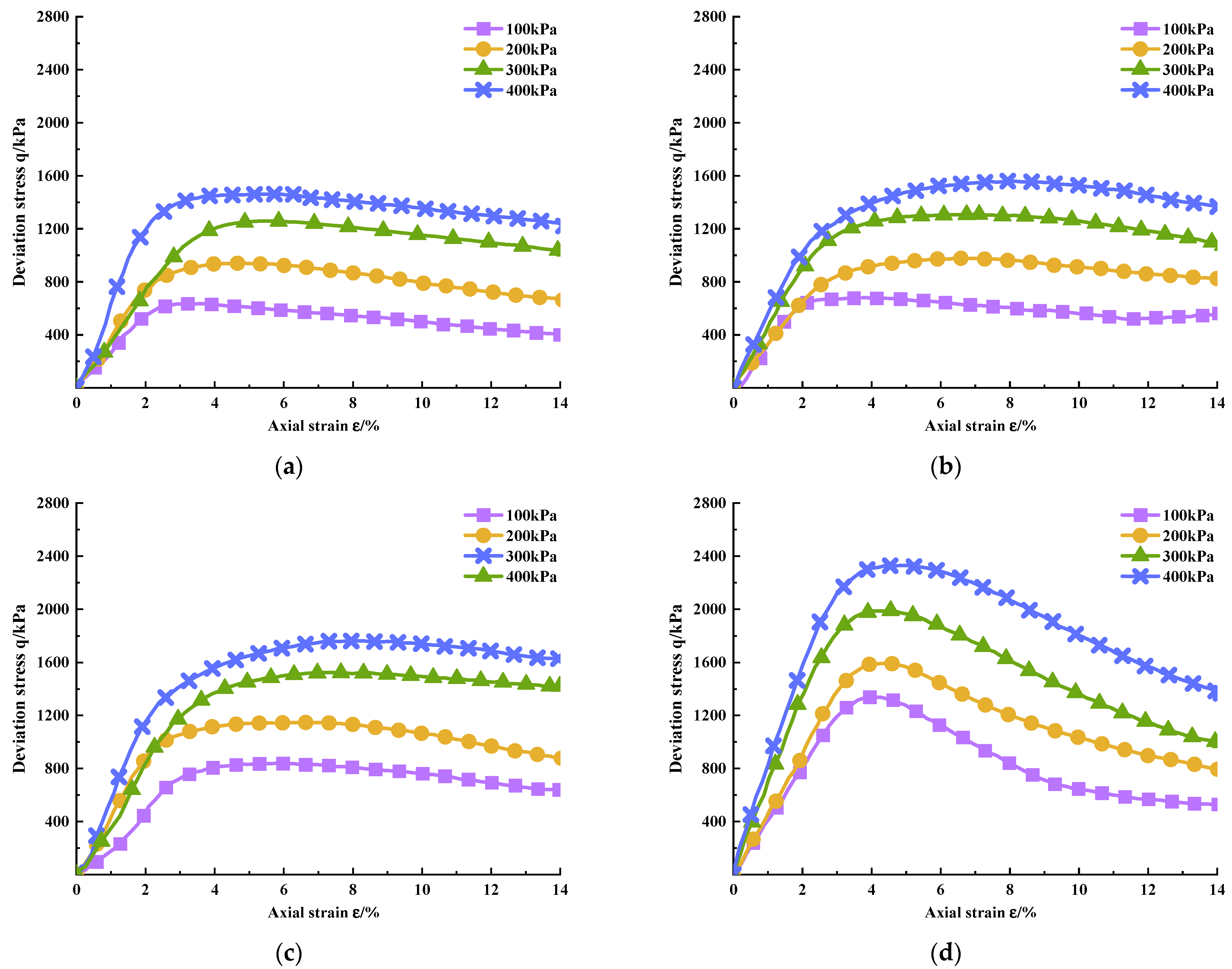
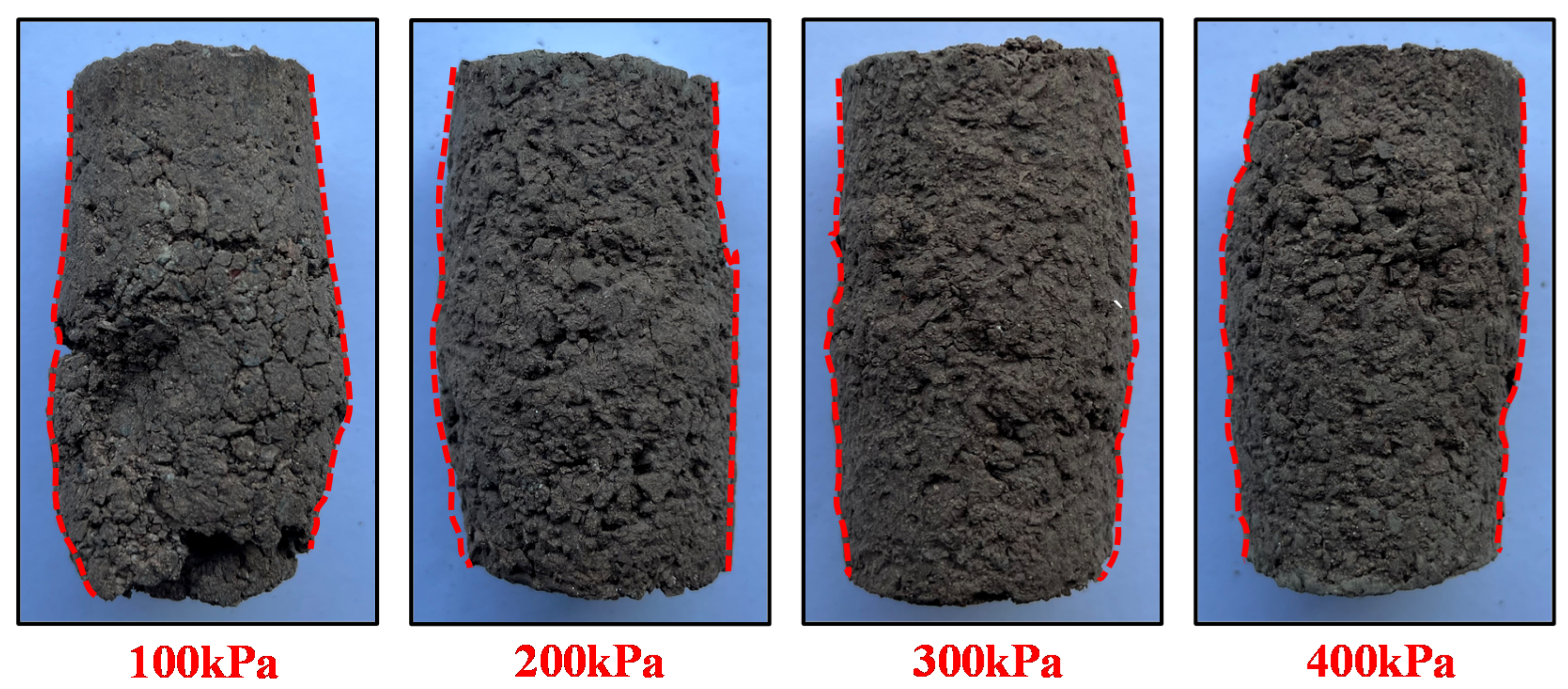
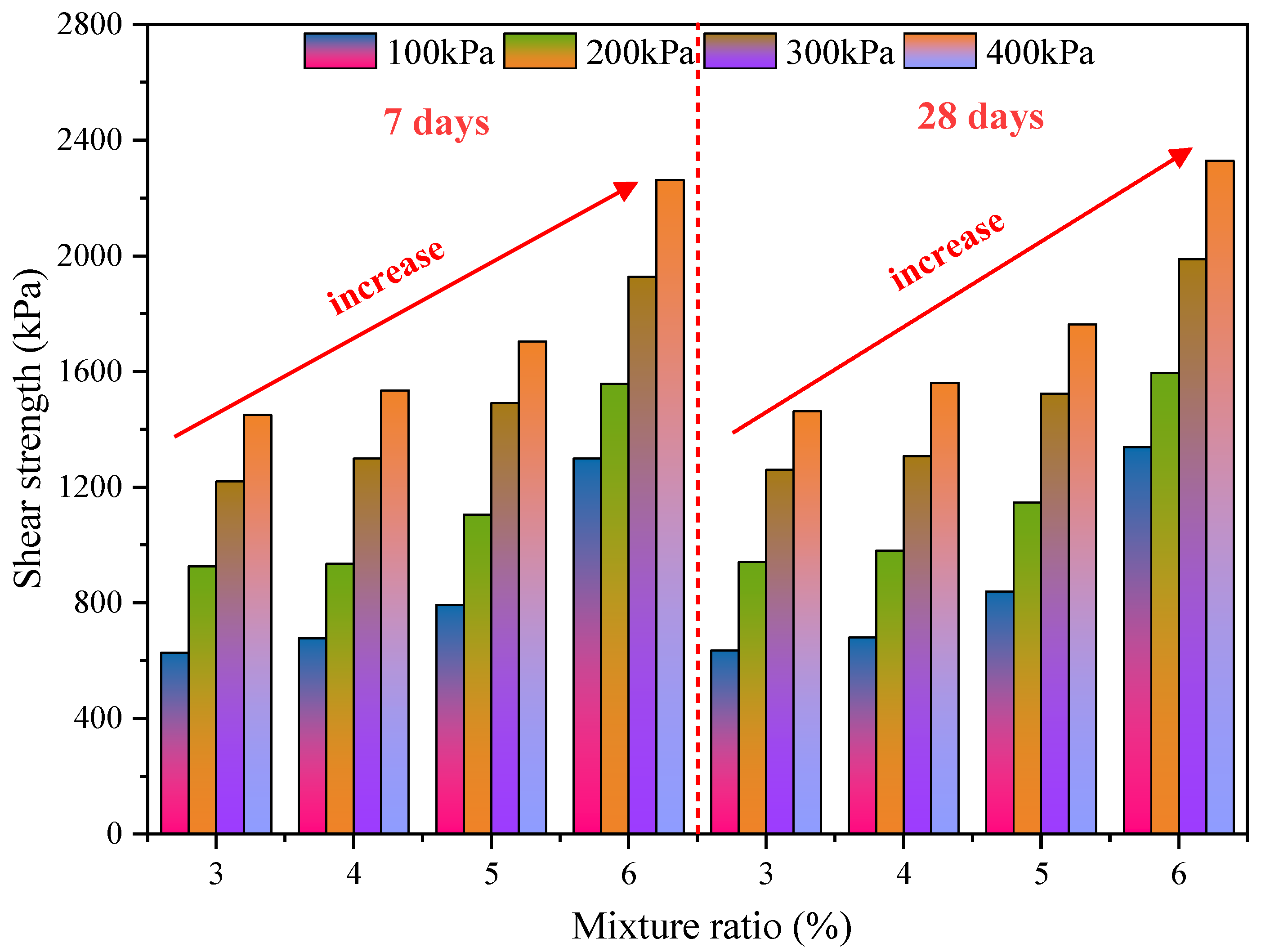
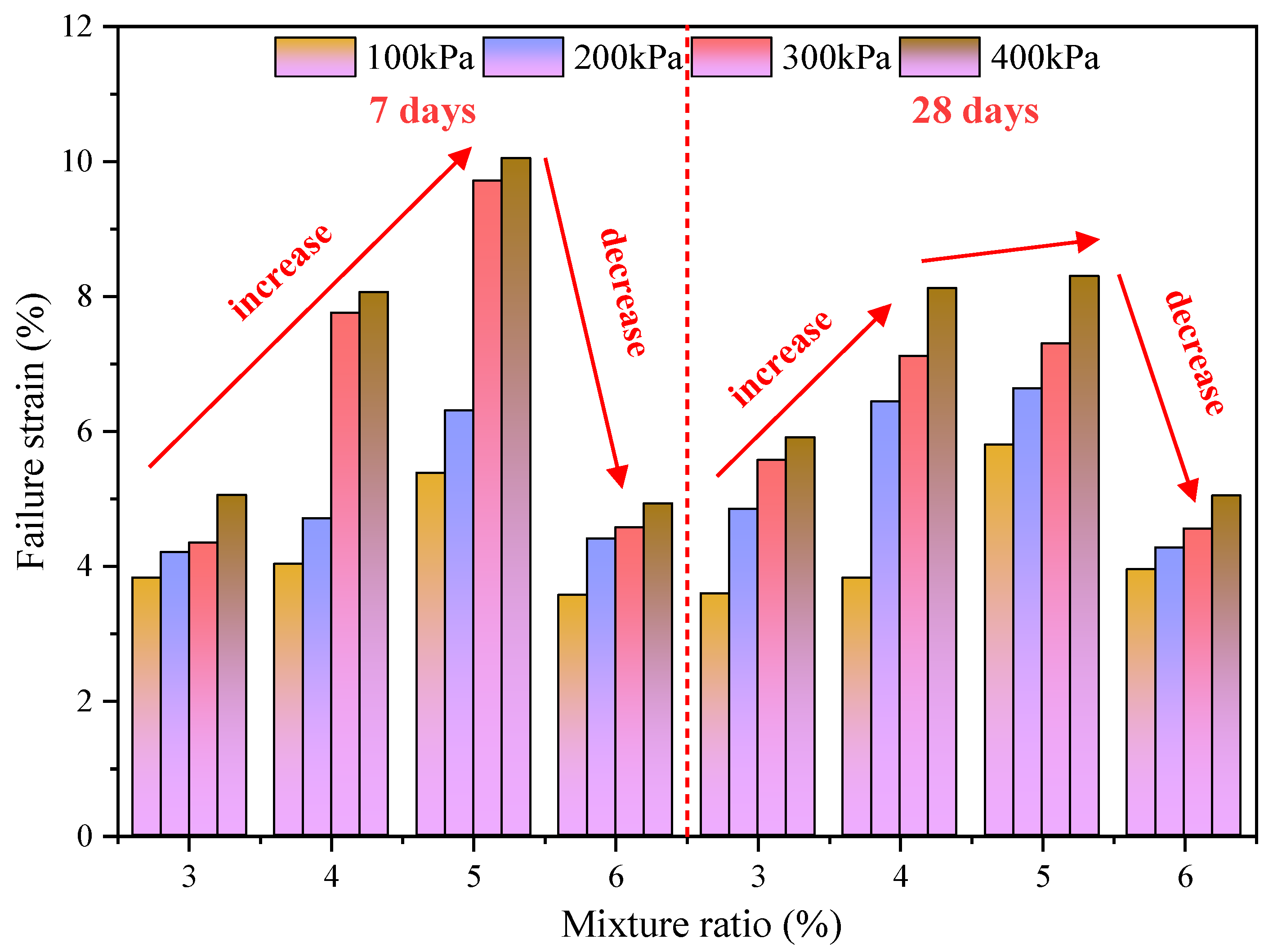

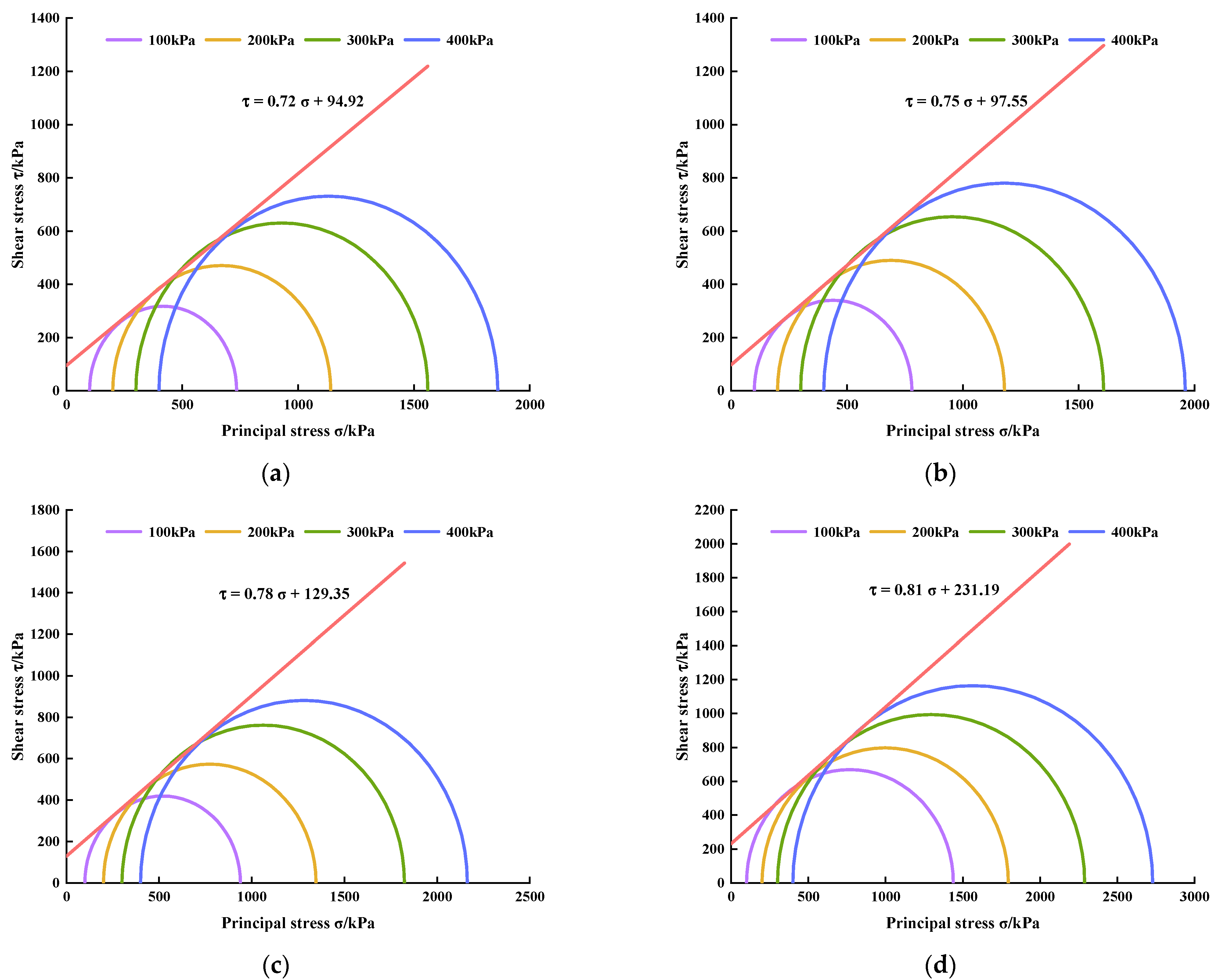
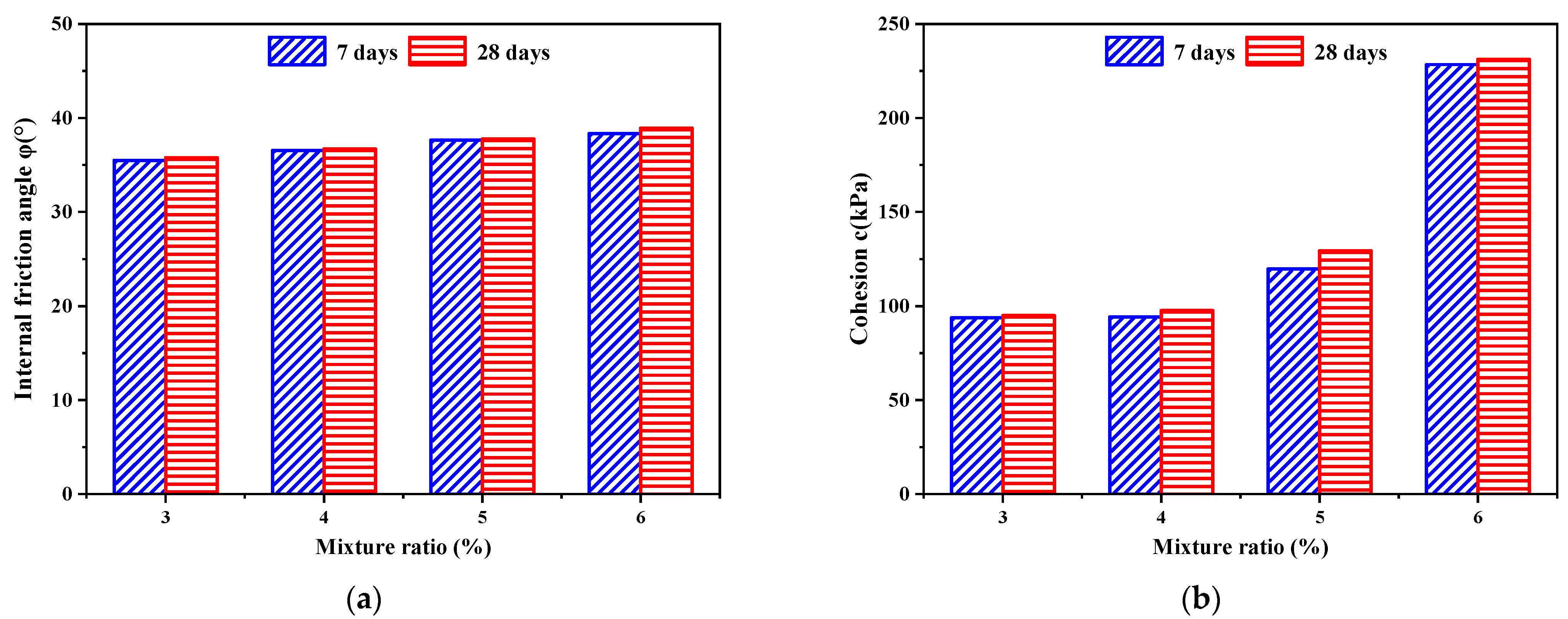

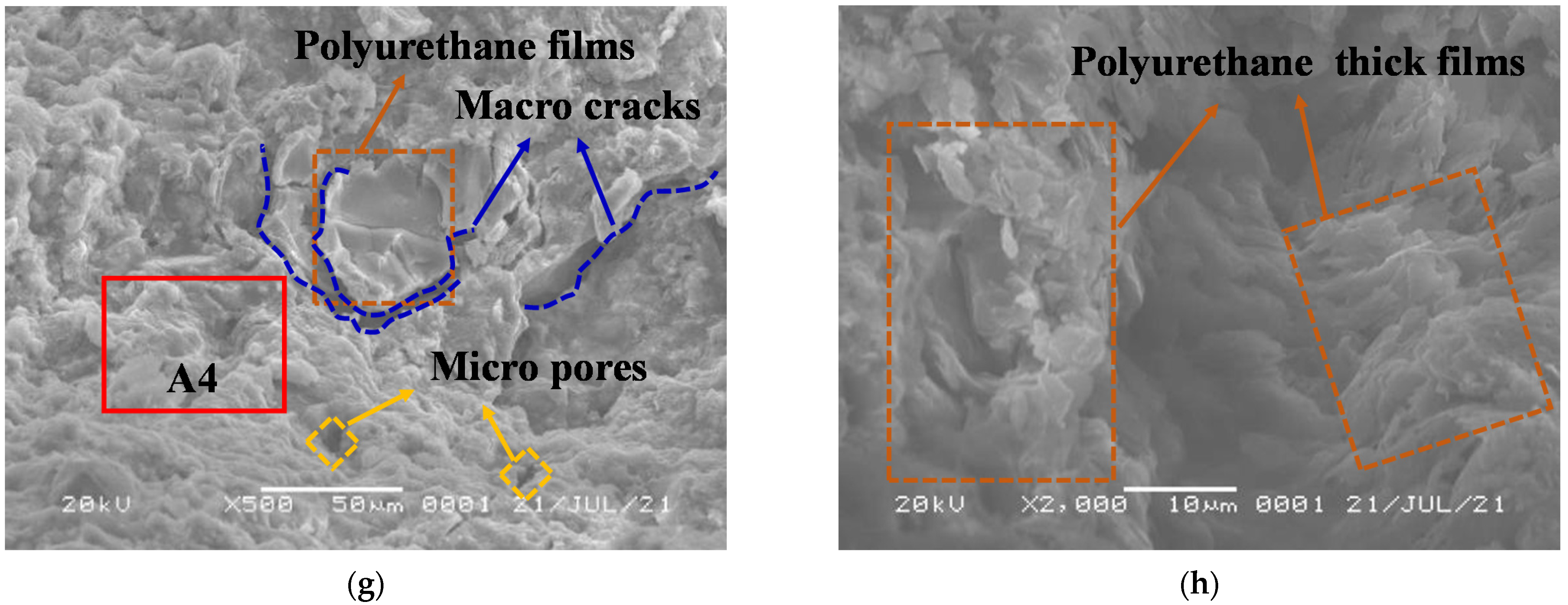
| Physical Index | Natural Moisture Content (%) | Plasticity Index | Proportion (g/cm3) | Mud Content (%) | Apparent Density (kg/m3) |
|---|---|---|---|---|---|
| Index value | 16 | 16.6 | 2.68 | 20.5 | 2.67 |
| Performance Index | Appearance | Solid Content (%) | pH Value (25 °C) | Viscosity (mPa∙S) | Film Forming Temperature (°C) |
|---|---|---|---|---|---|
| Index value | Milky white liquid | 40 | 6~8 | 800~1500 | 20 |
| Specimen Number | Dry Density (g/cm3) | WPU Content (%) | Moisture Content (%) | Curing Time (Day) |
|---|---|---|---|---|
| PURD-3 | 1.6 | 3 | 16 | 7, 28 |
| PURD-4 | 4 | |||
| PURD-5 | 5 | |||
| PURD-6 | 6 |
Publisher’s Note: MDPI stays neutral with regard to jurisdictional claims in published maps and institutional affiliations. |
© 2022 by the authors. Licensee MDPI, Basel, Switzerland. This article is an open access article distributed under the terms and conditions of the Creative Commons Attribution (CC BY) license (https://creativecommons.org/licenses/by/4.0/).
Share and Cite
Lv, B.; Zhao, Y.; Li, N.; Yu, Y.; Wu, Y.; Gu, M. Triaxial Mechanical Properties and Mechanism of Waterborne Polyurethane-Reinforced Road Demolition Waste as Road Bases. Polymers 2022, 14, 2725. https://doi.org/10.3390/polym14132725
Lv B, Zhao Y, Li N, Yu Y, Wu Y, Gu M. Triaxial Mechanical Properties and Mechanism of Waterborne Polyurethane-Reinforced Road Demolition Waste as Road Bases. Polymers. 2022; 14(13):2725. https://doi.org/10.3390/polym14132725
Chicago/Turabian StyleLv, Beifeng, Yinuo Zhao, Na Li, Yanfei Yu, Yanting Wu, and Miaojie Gu. 2022. "Triaxial Mechanical Properties and Mechanism of Waterborne Polyurethane-Reinforced Road Demolition Waste as Road Bases" Polymers 14, no. 13: 2725. https://doi.org/10.3390/polym14132725
APA StyleLv, B., Zhao, Y., Li, N., Yu, Y., Wu, Y., & Gu, M. (2022). Triaxial Mechanical Properties and Mechanism of Waterborne Polyurethane-Reinforced Road Demolition Waste as Road Bases. Polymers, 14(13), 2725. https://doi.org/10.3390/polym14132725





